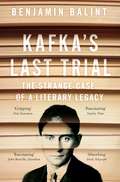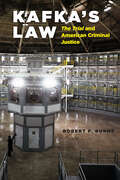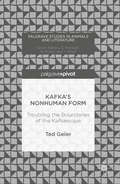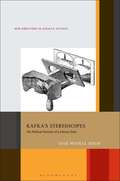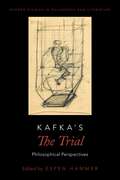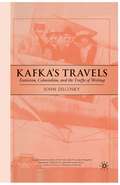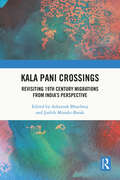- Table View
- List View
Kafka and Pinter: Shadow-Boxing
by R. ArmstrongKafka and Pinter is the first major study to focus on the extraordinary affinity between these two heavyweights of twentieth-century literature. As well as offering a bold new interpretation of Kafka's portrayal of the struggle between father and son in his classic stories The Judgement and The Metamorphosis , the book seeks to assess and document, through a detailed exposition of textual and other evidence, the extent to which Pinter's treatment of the same theme has been influenced by Kafka's example. Three of Pinter's plays - The Homecoming, Family Voices and Moonlight - are examined in depth, the last two more comprehensively perhaps than ever before. Clearly written and replete with all manner of fascinating parallels and interconnections, this book commends itself not only to students of Kafka and/or Pinter, but also to those with a more general interest in such areas as comparative literature, theatre studies, religion and psychology.
Kafka. Einbahnstrasse zur Hölle: Oder die unmögliche Selbstrechtfertigung des Daseins
by Elfie PoulainDie Autorin analysiert am Beispiel der Romane "Der Verschollene" und "Der Prozess", wie Kafkas Protagonisten als autonome Individuen unerlässlich um mitmenschliche Anerkennung ringen. Doch sie sind nur einem sozialen Hypertribunal ausgesetzt, das ihr Dasein zur Hölle macht. Der zerstörerische Prozess der Selbstrechtfertigung wird als unumgängliches Schicksal unserer Zeit veranschaulicht.
Kafka-Handbuch: Leben – Werk – Wirkung
Der wirkungsmächtigste deutschsprachige Schriftsteller des 20. Jahrhunderts. Franz Kafkas Werk gilt bis heute als Musterfall der ästhetischen Moderne. Das Handbuch präsentiert die Kontexte, in denen Kafka stand und stellt sein Leben sowie die wichtigsten Werke, Fragmente, Tagebücher und Briefe vor. Dabei wird deutlich, welchen Einfluss z. B. der Prager Kreis, Judentum/Zionismus, Philosophie, Psychoanalyse, Film und Fotografie auf Kafkas Texte hatten. Besonderer Wert wird erstmals auf die Entwicklungsgeschichte des Kafka schen Werkes gelegt.
Kafka in neuer Sicht: Mimik, Gestik und Personengefüge als Darstellungsformen des Autobiographischen
by Hartmut BinderKafka - Poetik der sinnlichen Welt: Strukturen sprachkritischen Erzählens. Germanistische Abhandlungen, Band 53
by Susanne KeßlerKafka Translated: How Translators have Shaped our Reading of Kafka
by Michelle WoodsKafka Translated is the first book to look at the issue of translation and Kafka's work. What effect do the translations have on how we read Kafka? Are our interpretations of Kafka influenced by the translators' interpretations? In what ways has Kafka been 'translated' into Anglo-American culture by popular culture and by academics? Michelle Woods investigates issues central to the burgeoning field of translation studies: the notion of cultural untranslatability; the centrality of female translators in literary history; and the under-representation of the influence of the translator as interpreter of literary texts. She specifically focuses on the role of two of Kafka's first translators, Milena Jesenská and Willa Muir, as well as two contemporary translators, Mark Harman and Michael Hofmann, and how their work might allow us to reassess reading Kafka. From here Woods opens up the whole process of translation and re-examines accepted and prevailing interpretations of Kafka's work.
Kafka Translated: How Translators have Shaped our Reading of Kafka
by Michelle WoodsKafka Translated is the first book to look at the issue of translation and Kafka's work. What effect do the translations have on how we read Kafka? Are our interpretations of Kafka influenced by the translators' interpretations? In what ways has Kafka been 'translated' into Anglo-American culture by popular culture and by academics? Michelle Woods investigates issues central to the burgeoning field of translation studies: the notion of cultural untranslatability; the centrality of female translators in literary history; and the under-representation of the influence of the translator as interpreter of literary texts. She specifically focuses on the role of two of Kafka's first translators, Milena Jesenská and Willa Muir, as well as two contemporary translators, Mark Harman and Michael Hofmann, and how their work might allow us to reassess reading Kafka. From here Woods opens up the whole process of translation and re-examines accepted and prevailing interpretations of Kafka's work.
Kafka und die Folgen
by Dieter Lamping„Ich bin Ende oder Anfang“, hat Kafka 1918 geschrieben. Wenn es eine Frage war, so ist sie entschieden, und zwar durch die Nachwelt. Kafka war ein Ende: sofern er einer Welt angehörte, die im europäischen Totalitarismus untergegangen ist, der Welt des deutschsprachigen Prager Judentums vor 1933. Kafka ist aber auch ein Anfang: eine zentrale Figur der Moderne, von einer Ausstrahlung, die weit über die Literatur hinausgeht, aber in der Literatur besonders wirksam ist. Was Kafkas Werk und besonders seine Art des Erzählens ausmacht, skizziert der Band ebenso wie seine Wirkung, vor allem auf Philosophen und Schriftsteller von Theodor W. Adorno und Hannah Arendt bis zu Peter Handke und Mario Vargas Llosa.
Kafka's Last Trial: The Case of a Literary Legacy
by Benjamin Balint'Fascinating and forensically scrupulous.' John Banville, GuardianWhen Franz Kafka died in 1924, his loyal champion Max Brod could not bring himself to fulfil his friend’s last instruction: to burn his remaining manuscripts. Instead, Brod devoted the rest of his life to editing, publishing and canonizing Kafka’s work. By betraying his friend’s last wish, Brod twice rescued his legacy – first from physical destruction, and then from obscurity. But that betrayal was also eventually to lead to an international legal battle: as a writer in German, should Kafka’s papers come to rest in Germany, where his three sisters died as victims of the Holocaust? Or, as a Jewish writer, should his work be considered as a cultural inheritance of Israel, a state that did not exist at the time of his death?Alongside an acutely observed portrait of Kafka, Benjamin Balint also traces the journey of the manuscripts Brod had rescued when he fled from Prague to Palestine in 1939 and offers a gripping account of the Israeli court case that determined their fate. He tells of a wrenching escape from the Nazi invaders of Czechoslovakia; of a love affair between exiles stranded in Tel Aviv; and of two countries whose national obsessions with the past eventually faced off in the courts. For fans of Philippe Sands' East West Street, in Kafka’s Last Trial Benjamin Balint invites us to consider Kafka’s remarkable legacy and to question whether that legacy belongs by right to the country of his language, that of his birth, or that of his cultural affinities – but also whether any nation state can lay claim to ownership of a writer’s work at all.
Kafka's Law: "The Trial" and American Criminal Justice
by Robert P. BurnsThe Trial is actually closer to reality than fantasy as far as the client’s perception of the system. It’s supposed to be a fantastic allegory, but it’s reality. It’s very important that lawyers read it and understand this.” Justice Anthony Kennedy famously offered this assessment of the Kafkaesque character of the American criminal justice system in 1993. While Kafka’s vision of the “Law” in The Trial appears at first glance to be the antithesis of modern American legal practice, might the characteristics of this strange and arbitrary system allow us to identify features of our own system that show signs of becoming similarly nightmarish? With Kafka’s Law, Robert P. Burns shows how The Trial provides an uncanny lens through which to consider flaws in the American criminal justice system today. Burns begins with the story, at once funny and grim, of Josef K., caught in the Law’s grip and then crushed by it. Laying out the features of the Law that eventually destroy K., Burns argues that the American criminal justice system has taken on many of these same features. In the overwhelming majority of contemporary cases, police interrogation is followed by a plea bargain, in which the court’s only function is to set a largely predetermined sentence for an individual already presumed guilty. Like Kafka’s nightmarish vision, much of American criminal law and procedure has become unknowable, ubiquitous, and bureaucratic. It, too, has come to rely on deception in dealing with suspects and jurors, to limit the role of defense, and to increasingly dispense justice without the protection of formal procedures. But, while Kennedy may be correct in his grim assessment, a remedy is available in the tradition of trial by jury, and Burns concludes by convincingly arguing for its return to a more central place in American criminal justice.
Kafka's Law: "The Trial" and American Criminal Justice
by Robert P. BurnsThe Trial is actually closer to reality than fantasy as far as the client’s perception of the system. It’s supposed to be a fantastic allegory, but it’s reality. It’s very important that lawyers read it and understand this.” Justice Anthony Kennedy famously offered this assessment of the Kafkaesque character of the American criminal justice system in 1993. While Kafka’s vision of the “Law” in The Trial appears at first glance to be the antithesis of modern American legal practice, might the characteristics of this strange and arbitrary system allow us to identify features of our own system that show signs of becoming similarly nightmarish? With Kafka’s Law, Robert P. Burns shows how The Trial provides an uncanny lens through which to consider flaws in the American criminal justice system today. Burns begins with the story, at once funny and grim, of Josef K., caught in the Law’s grip and then crushed by it. Laying out the features of the Law that eventually destroy K., Burns argues that the American criminal justice system has taken on many of these same features. In the overwhelming majority of contemporary cases, police interrogation is followed by a plea bargain, in which the court’s only function is to set a largely predetermined sentence for an individual already presumed guilty. Like Kafka’s nightmarish vision, much of American criminal law and procedure has become unknowable, ubiquitous, and bureaucratic. It, too, has come to rely on deception in dealing with suspects and jurors, to limit the role of defense, and to increasingly dispense justice without the protection of formal procedures. But, while Kennedy may be correct in his grim assessment, a remedy is available in the tradition of trial by jury, and Burns concludes by convincingly arguing for its return to a more central place in American criminal justice.
Kafka's Law: "The Trial" and American Criminal Justice
by Robert P. BurnsThe Trial is actually closer to reality than fantasy as far as the client’s perception of the system. It’s supposed to be a fantastic allegory, but it’s reality. It’s very important that lawyers read it and understand this.” Justice Anthony Kennedy famously offered this assessment of the Kafkaesque character of the American criminal justice system in 1993. While Kafka’s vision of the “Law” in The Trial appears at first glance to be the antithesis of modern American legal practice, might the characteristics of this strange and arbitrary system allow us to identify features of our own system that show signs of becoming similarly nightmarish? With Kafka’s Law, Robert P. Burns shows how The Trial provides an uncanny lens through which to consider flaws in the American criminal justice system today. Burns begins with the story, at once funny and grim, of Josef K., caught in the Law’s grip and then crushed by it. Laying out the features of the Law that eventually destroy K., Burns argues that the American criminal justice system has taken on many of these same features. In the overwhelming majority of contemporary cases, police interrogation is followed by a plea bargain, in which the court’s only function is to set a largely predetermined sentence for an individual already presumed guilty. Like Kafka’s nightmarish vision, much of American criminal law and procedure has become unknowable, ubiquitous, and bureaucratic. It, too, has come to rely on deception in dealing with suspects and jurors, to limit the role of defense, and to increasingly dispense justice without the protection of formal procedures. But, while Kennedy may be correct in his grim assessment, a remedy is available in the tradition of trial by jury, and Burns concludes by convincingly arguing for its return to a more central place in American criminal justice.
Kafka's Law: "The Trial" and American Criminal Justice
by Robert P. BurnsThe Trial is actually closer to reality than fantasy as far as the client’s perception of the system. It’s supposed to be a fantastic allegory, but it’s reality. It’s very important that lawyers read it and understand this.” Justice Anthony Kennedy famously offered this assessment of the Kafkaesque character of the American criminal justice system in 1993. While Kafka’s vision of the “Law” in The Trial appears at first glance to be the antithesis of modern American legal practice, might the characteristics of this strange and arbitrary system allow us to identify features of our own system that show signs of becoming similarly nightmarish? With Kafka’s Law, Robert P. Burns shows how The Trial provides an uncanny lens through which to consider flaws in the American criminal justice system today. Burns begins with the story, at once funny and grim, of Josef K., caught in the Law’s grip and then crushed by it. Laying out the features of the Law that eventually destroy K., Burns argues that the American criminal justice system has taken on many of these same features. In the overwhelming majority of contemporary cases, police interrogation is followed by a plea bargain, in which the court’s only function is to set a largely predetermined sentence for an individual already presumed guilty. Like Kafka’s nightmarish vision, much of American criminal law and procedure has become unknowable, ubiquitous, and bureaucratic. It, too, has come to rely on deception in dealing with suspects and jurors, to limit the role of defense, and to increasingly dispense justice without the protection of formal procedures. But, while Kennedy may be correct in his grim assessment, a remedy is available in the tradition of trial by jury, and Burns concludes by convincingly arguing for its return to a more central place in American criminal justice.
Kafka’s Nonhuman Form: Troubling the Boundaries of the Kafkaesque (Palgrave Studies in Animals and Literature)
by Ted GeierThis book is a compact study of Kafka’s inimitable literary style, animals, and ecological thought—his nonhuman form—that proceeds through original close readings of Kafka’s oeuvre. With select engagements of Adorno, Derrida, and the literary heritage from Romanticism to Dickens that influenced Kafka, Ted Geier discusses Kafka’s literary, “nonhuman” form and the way it unsettles the notion of a natural and simple existence that society and culture impose, including the boundaries between human and animal. Through careful attention to the formal predicaments of Kafka’s works and engaging with Kafka’s original legal and social thought in his novels and short stories, this book renders Kafka’s sometimes impossibly enigmatic work legible at the level of its expression, bringing surprising shape to his work and redefining what scholars and readers have understood as the “Kafkaesque”.
Kafka’s Stereoscopes: The Political Function of a Literary Style (New Directions in German Studies)
by Isak Winkel HolmIn 1911, Franz Kafka encountered the Kaiser Panorama: a stereoscopic peep show offering an illusion of three-dimensional depth. After the experience, he began to emulate the apparatus in his literary sketches, developing a style we might call "stereoscopic," juxtaposing, like the optical stereoscope, two images of the same object seen from slightly different perspectives.Isak Winkel Holm argues that Kafka's stereoscopic style is crucial to an understanding of the relation between literature and politics in Kafka's work. At the level of content, the stereoscopic style offers a representation of the basic order of a specific community. At the level of form, the stereoscopic style is structured as the juxtaposition of two dissimilar images of the same community. At the level of function, finally, the style provokes a reconsideration, and perhaps even a reconfiguration, of the social order itself. With insights from literary studies, philosophical aesthetics and political theory, Kafka's Stereoscopes offers a detailed but highly readable argument for the relevance of Kafka's literary works in today's political reality.
Kafka’s Stereoscopes: The Political Function of a Literary Style (New Directions in German Studies #28)
by Isak Winkel HolmIn 1911, Franz Kafka encountered the Kaiser Panorama: a stereoscopic peep show offering an illusion of three-dimensional depth. After the experience, he began to emulate the apparatus in his literary sketches, developing a style we might call "stereoscopic," juxtaposing, like the optical stereoscope, two images of the same object seen from slightly different perspectives.Isak Winkel Holm argues that Kafka's stereoscopic style is crucial to an understanding of the relation between literature and politics in Kafka's work. At the level of content, the stereoscopic style offers a representation of the basic order of a specific community. At the level of form, the stereoscopic style is structured as the juxtaposition of two dissimilar images of the same community. At the level of function, finally, the style provokes a reconsideration, and perhaps even a reconfiguration, of the social order itself. With insights from literary studies, philosophical aesthetics and political theory, Kafka's Stereoscopes offers a detailed but highly readable argument for the relevance of Kafka's literary works in today's political reality.
KAFKA'S THE TRIAL OXPL C: Philosophical Perspectives (Oxford Studies in Philosophy and Lit)
by Philosophical PerspectivesKafka's novel The Trial, written from 1914 to 1915 and published in 1925, is a multi-faceted, notoriously difficult manifestation of European literary modernism, and one of the most emblematic books of the 20th Century. It tells the story of Josef K., a man accused of a crime he has no recollection of committing and whose nature is never revealed to him. The novel is often interpreted theologically as an expression of radical nihilism and a world abandoned by God. It is also read as a parable of the cold, inhumane rationality of modern bureaucratization. Like many other novels of this turbulent period, it offers a tragic quest-narrative in which the hero searches for truth and clarity (whether about himself, or the anonymous system he is facing), only to fall into greater and greater confusion. This collection of nine new essays and an editor's introduction brings together Kafka experts, intellectual historians, literary scholars, and philosophers in order to explore the novel's philosophical and theological significance. Authors pursue the novel's central concerns of justice, law, resistance, ethics, alienation, and subjectivity. Few novels display human uncertainty and skepticism in the face of rapid modernization, or the metaphysical as it intersects with the most mundane aspects of everyday life, more insistently than The Trial. Ultimately, the essays in this collection focus on how Kafka's text is in fact philosophical in the ways in which it achieves its literary aims. Rather than considering ideas as externally related to the text, the text is considered philosophical at the very level of literary form and technique.
Kafka's Travels: Exoticism, Colonialism, and the Traffic of Writing
by J. ZilcoskyIn 1916, Kafka writes of The Sugar Baron , a dime-store colonial adventure novel, '[it] affects me so deeply that I feel it is about myself, or as if it were the book of rules for my life.' John Zilcosky reveals that this perhaps surprising statement - made by the Prague-bound poet of modern isolation - is part of a network of remarks that exemplify Kafka's ongoing preoccupation with popular travel writing, exoticism, and colonial fantasy. Taking this biographical peculiarity as a starting point, Kafka's Travels elegantly re-reads Kafka's major works ( Amerika , The Trial , The Castle ) through the lens of fin-de siecle travel culture. Making use of previously unexplored literary and cultural materials - travel diaries, train schedules, tour guides, adventure novels - Zilcosky argues that Kafka's uniquely modern metaphorics of alienation emerges out of the author's complex encounter with the utopian travel discourses of his day.
Kafka's The Trial: Philosophical Perspectives (Oxford Studies in Philosophy and Lit)
Kafka's novel The Trial, written from 1914 to 1915 and published in 1925, is a multi-faceted, notoriously difficult manifestation of European literary modernism, and one of the most emblematic books of the 20th Century. It tells the story of Josef K., a man accused of a crime he has no recollection of committing and whose nature is never revealed to him. The novel is often interpreted theologically as an expression of radical nihilism and a world abandoned by God. It is also read as a parable of the cold, inhumane rationality of modern bureaucratization. Like many other novels of this turbulent period, it offers a tragic quest-narrative in which the hero searches for truth and clarity (whether about himself, or the anonymous system he is facing), only to fall into greater and greater confusion. This collection of nine new essays and an editor's introduction brings together Kafka experts, intellectual historians, literary scholars, and philosophers in order to explore the novel's philosophical and theological significance. Authors pursue the novel's central concerns of justice, law, resistance, ethics, alienation, and subjectivity. Few novels display human uncertainty and skepticism in the face of rapid modernization, or the metaphysical as it intersects with the most mundane aspects of everyday life, more insistently than The Trial. Ultimately, the essays in this collection focus on how Kafka's text is in fact philosophical in the ways in which it achieves its literary aims. Rather than considering ideas as externally related to the text, the text is considered philosophical at the very level of literary form and technique.
Kafka's Zoopoetics: Beyond the Human-Animal Barrier
by Naama HarelNonhuman figures are ubiquitous in the work of Franz Kafka, from his early stories down to his very last one. Despite their prominence throughout his oeuvre, Kafka’s animal representations have been considered first and foremost as mere allegories of intrahuman matters. In recent years, the allegorization of Kafka’s animals has been poetically dismissed by Kafka’s commentators and politically rejected by posthumanist scholars. Such critique, however, has yet to inspire either an overarching or an interdiscursive account. This book aims to fill this lacuna. Positing animal stories as a distinct and significant corpus within Kafka’s entire poetics, and closely examining them in dialogue with both literary and posthumanist analysis, Kafka’s Zoopoetics critically revisits animality, interspecies relations, and the very human-animal contradistinction in the writings of Franz Kafka. Kafka’s animals typically stand at the threshold between humanity and animality, fusing together human and nonhuman features. Among his liminal creatures we find a human transformed into vermin (in “The Metamorphosis”), an ape turned into a human being (in “A Report to an Academy”), talking jackals (in “Jackals and Arabs”), a philosophical dog (in “Researches of a Dog”), a contemplative mole-like creature (in “The Burrow”), and indiscernible beings (in “Josefine, the Singer or the Mouse People”). Depicting species boundaries as mutable and obscure, Kafka creates a fluid human-animal space, which can be described as “humanimal.” The constitution of a humanimal space radically undermines the stark barrier between human and other animals, dictated by the anthropocentric paradigm. Through denying animalistic elements in humans, and disavowing the agency of nonhuman animals, excluding them from social life, and neutralizing compassion for them, this barrier has been designed to regularize both humanity and animality. The contextualization of Kafka's animals within posthumanist theory engenders a post-anthropocentric arena, which is simultaneously both imagined and very real.
Kairós: In Defence of 'Due Time'
by Giacomo MarramaoShedding new light on the fundamental philosophical problem of time, leading Italian philosopher Giacomo Marramao offers a solution to today's 24/7 culture. If we were asked to name the social syndrome of our age under capitalism, it would no doubt be “rush”. Intentional animals as we are, we experience the meaningless acceleration of time, which devours instants and misses its target just like its opposite, undue hesitation. For Marramao, rush and slowness or rashness and hesitation are two mirror forms of untimeliness: two unsuitable ways of seizing time. Through engagement with sources including Heidegger, Bergson, Saint Paul the Apostle, Newtonian physics, and postmodern theory, Marramao calls for a change to how we perceive time. Delving into the Greek and Roman concepts of tempus, chronos, and aión, he argues that there should be no opposition between the scientific-objective time and the existential-subjective one. As such, he introduces his own theory of kairós, or “due time”, as the notion of fertile and decisive timeliness. A timely decision, Marramao advances, is generated by the productive tension between opposites: a tension created equally by swiftness and caution, promptness and conformity with the action's purpose. Originally published in 1992, this updated edition of Kairós: In Defence of “Due Time'' includes a new preface speaking to today's social and political climate, as well as an introduction by Marramao himself, in which he reflects on his long engagement with temporality from Power and Secularization up until today.
Kairós: In Defence of 'Due Time'
by Giacomo MarramaoShedding new light on the fundamental philosophical problem of time, leading Italian philosopher Giacomo Marramao offers a solution to today's 24/7 culture. If we were asked to name the social syndrome of our age under capitalism, it would no doubt be “rush”. Intentional animals as we are, we experience the meaningless acceleration of time, which devours instants and misses its target just like its opposite, undue hesitation. For Marramao, rush and slowness or rashness and hesitation are two mirror forms of untimeliness: two unsuitable ways of seizing time. Through engagement with sources including Heidegger, Bergson, Saint Paul the Apostle, Newtonian physics, and postmodern theory, Marramao calls for a change to how we perceive time. Delving into the Greek and Roman concepts of tempus, chronos, and aión, he argues that there should be no opposition between the scientific-objective time and the existential-subjective one. As such, he introduces his own theory of kairós, or “due time”, as the notion of fertile and decisive timeliness. A timely decision, Marramao advances, is generated by the productive tension between opposites: a tension created equally by swiftness and caution, promptness and conformity with the action's purpose. Originally published in 1992, this updated edition of Kairós: In Defence of “Due Time'' includes a new preface speaking to today's social and political climate, as well as an introduction by Marramao himself, in which he reflects on his long engagement with temporality from Power and Secularization up until today.
Kala Pani Crossings: Revisiting 19th Century Migrations from India’s Perspective
by Ashutosh Bhardwaj Judith Misrahi-BarakWhen used in India, the term Kala pani refers to the cellular jail in Port Blair, where the British colonisers sent a select category of freedom fighters. In the diaspora it refers to the transoceanic migration of indentured labour from India to plantation colonies across the globe from the mid-19th century onwards. This volume discusses the legacies of indenture in the Caribbean, Reunion, Mauritius, and Fiji, and how they still imbue our present. More importantly, it draws attention to India and raises new questions: doesn’t one need, at some stage, to wonder why this forgotten chapter of Indian history needs to be retrieved? How is it that this history is better known outside India than in India itself? What are the advantages of shining a torch onto a history that was made invisible? Why have the tribulations of the old diaspora been swept under the carpet at a time when the successes of the new diaspora have been foregrounded? What do we stand to gain from resurrecting these histories in the early 21st century and from shifting our perspectives? A key volume on Indian diaspora, modern history, indentured labour, and the legacy of indentureship, this co-edited collection of essays examines these questions largely through the frame of important works of literature and cinema, folk songs, and oral tales, making it an artistic enquiry of the past and of the present. It will be of great interest to scholars and researchers of world history, especially labour history, literature, postcolonial studies, cultural studies, diaspora studies, sociology and social anthropology, Indian Ocean studies, and South Asian studies.
Kala Pani Crossings: Revisiting 19th Century Migrations from India’s Perspective
by Ashutosh Bhardwaj Judith Misrahi-BarakWhen used in India, the term Kala pani refers to the cellular jail in Port Blair, where the British colonisers sent a select category of freedom fighters. In the diaspora it refers to the transoceanic migration of indentured labour from India to plantation colonies across the globe from the mid-19th century onwards. This volume discusses the legacies of indenture in the Caribbean, Reunion, Mauritius, and Fiji, and how they still imbue our present. More importantly, it draws attention to India and raises new questions: doesn’t one need, at some stage, to wonder why this forgotten chapter of Indian history needs to be retrieved? How is it that this history is better known outside India than in India itself? What are the advantages of shining a torch onto a history that was made invisible? Why have the tribulations of the old diaspora been swept under the carpet at a time when the successes of the new diaspora have been foregrounded? What do we stand to gain from resurrecting these histories in the early 21st century and from shifting our perspectives? A key volume on Indian diaspora, modern history, indentured labour, and the legacy of indentureship, this co-edited collection of essays examines these questions largely through the frame of important works of literature and cinema, folk songs, and oral tales, making it an artistic enquiry of the past and of the present. It will be of great interest to scholars and researchers of world history, especially labour history, literature, postcolonial studies, cultural studies, diaspora studies, sociology and social anthropology, Indian Ocean studies, and South Asian studies.








